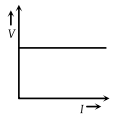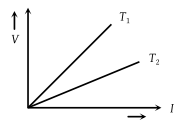Following figure shows cross-sections through three long conductors of the same length and material, with square cross-section of edge lengths as shown. Conductor B will fit snugly within conductor A, and conductor C will fit snugly within conductor B. Relationship between their end to end resistance is

(1) RA = RB = RC
(2) RA > RB > RC
(3) RA < RB < R
(4) Information is not sufficient

In the following star circuit diagram (figure), the equivalent resistance between the points A and H will be
(1) 1.944 r
(2) 0.973 r
(3) 0.486 r
(4) 0.243 r
In the circuit of adjoining figure the current through 12 Ω resister will be
(1) 1 A
(2)
(3)
(4) 0 A
The resistance of the series combination of two resistance is S. When they are joined in parallel the total resistance is P. If S = nP, then the minimum possible value of n is :
(1) 4
(2) 3
(3) 2
(4) 1
Which of the adjoining graphs represents ohmic resistance ?
(1)
(2)
(3)
(4)
Variation of current passing through a conductor with the voltage applied across its ends varies is shown in the diagram below. If the resistance \((R)\) is determined at points \(A\), \(B\), \(C\) and \(D\), we will find that:

| 1. | \(R_C = R_D\) | 2. | \(R_B>R_A\) |
| 3. | \(R_C>R_B\) | 4. | None of these |
The voltage V and current I graph for a conductor at two different temperatures T1 and T2 are shown in the figure. The relation between T1 and T2 is :
(1) T1 > T2
(2)
(3) T1 = T2
(4) T1 < T2
From the graph between current \(I\) and voltage \(V\) shown below, identify the portion corresponding to negative resistance
1. \(AB\)
2. \(BC\)
3. \(CD\)
4. \(DE\)
I-V characteristic of a copper wire of length L and area of cross-section A is shown in figure. The slope of the curve becomes :
(1) More if the experiment is performed at higher temperature
(2) More if a wire of steel of same dimension is used
(3) More if the length of the wire is increased
(4) Less if the length of the wire is increased
E denotes electric field in a uniform conductor, I corresponding current through it, Vd drifts velocity of electrons and P denotes thermal power produced in the conductor, then which of the following graph is incorrect :
(1)
(2)
(3)
(4)



















